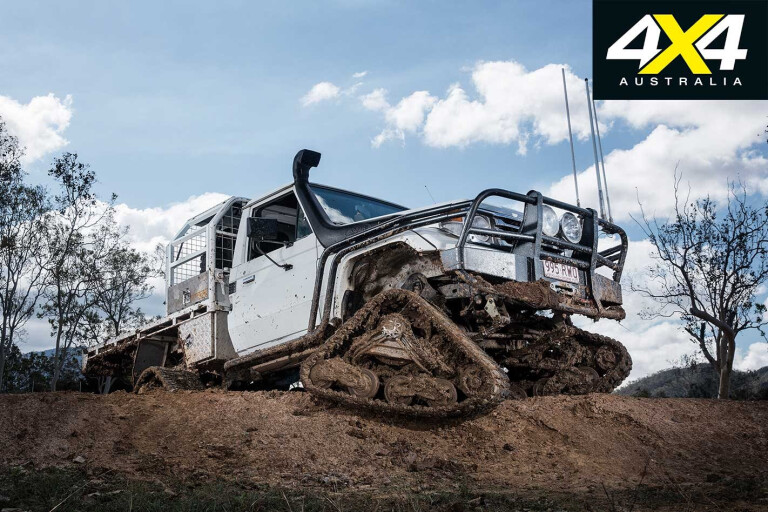
IF YOU were unfortunate enough to see the movie Fate of the Furious you may have noticed a tracked RAM pick-up in one scene. Ken Block of Hoonigan fame has even hit the ski slopes with a tracked Ford Raptor.
For us, however, it was an exceedingly cool Hemi-powered FC-Jeep shod with tracks – built by Daystar for SEMA 2014 – that had us contemplating a product called Mattracks. It turns out Mattracks are available in Australia, and we wanted to have a crack at these things off-road to see if they are as capable as they look.
Townsville-based Fire Express is the Australian distributor of Mattracks, and we caught up with Mark Dooley, the owner and director of Fire Express, to get the low down on converting a 4x4 to a tracked off-road weapon.
The Mattracks essentially bolt on to a vehicle’s existing stud pattern, and they can be removed any time and the wheels refitted reasonably easily. Some minor modifications are required to initially install the tracks, but then it’s up to you if you need to swap between wheels and tracks – these bolt-on mods don’t interfere with wheeled operation if you whack your wheels and tyres back on.
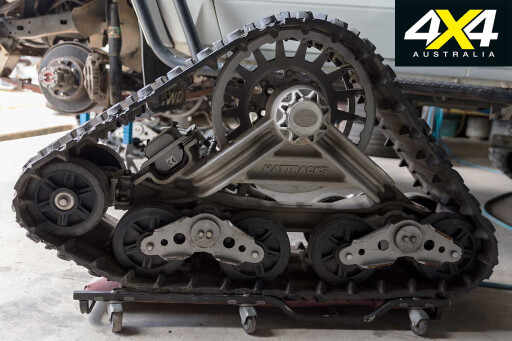 The main advantage of a tracked vehicle is low ground pressure and, as mud, snow and sand all pose challenges for wheeled vehicles, tracks basically provide a bigger yet lighter footprint. For example, the Land Cruiser you see here has a ground pressure of just 14kPa. To put that into perspective, while driving this set-up, I pulled up in a dry creek bed, hopped out and sank up to my ankles in sand, but the Cruiser barely broke the surface.
The main advantage of a tracked vehicle is low ground pressure and, as mud, snow and sand all pose challenges for wheeled vehicles, tracks basically provide a bigger yet lighter footprint. For example, the Land Cruiser you see here has a ground pressure of just 14kPa. To put that into perspective, while driving this set-up, I pulled up in a dry creek bed, hopped out and sank up to my ankles in sand, but the Cruiser barely broke the surface.
According to Dooley it was the aftermath of Cyclone Yasi in 2011 that sowed the seed for local Mattracks distribution. After Yasi had slammed into the North Queensland coast, leaving a trail of destruction in its wake, Dooley noted the emergency services were having difficulty getting around in flooded and waterlogged areas. Consequently, he thought Mattracks may have potential in the Australian market.
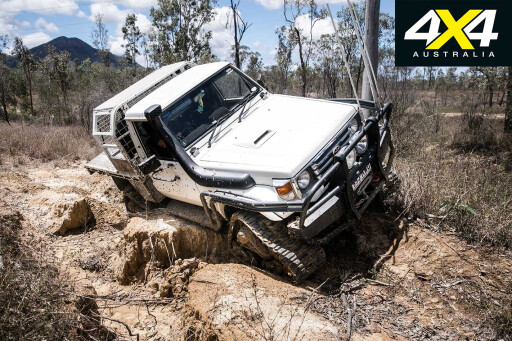 For our demo drive Dooley fitted a set of these tracks to his son’s lightly modified LC75, but before we could make some marks in the mud I got to have a look at the installation and what it requires. In the case of the Cruiser, you have to remember to lock the hubs before fitting the tracks, as failure to do so means you’ll have to pull the front track units off again to lock them.
For our demo drive Dooley fitted a set of these tracks to his son’s lightly modified LC75, but before we could make some marks in the mud I got to have a look at the installation and what it requires. In the case of the Cruiser, you have to remember to lock the hubs before fitting the tracks, as failure to do so means you’ll have to pull the front track units off again to lock them.
To prevent the track units from rotating on their hubs when off-road, the brackets are fitted to the ball joints at the front and the rear spring hangers. A rubber torsion block within the unit’s housing ensures the tracks tilt upwards when confronted with an obstacle, rather than trying to rotate downwards on the hub.
There’s an optional power assist function you’d be mad not to opt for – it requires a pressure sensor and quick-release fittings to be mounted to the power steering box – as this makes turning much easier, as it raises the forward rollers as you turn the wheel, reducing drag and friction on the tracks.
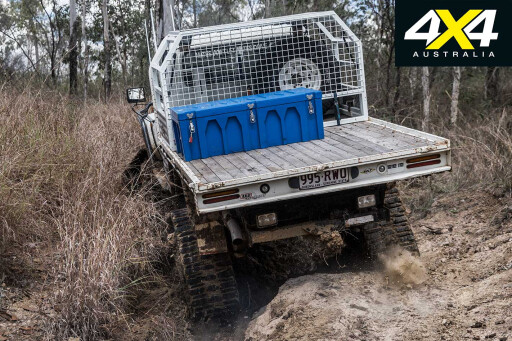 Whether you can legally drive them on the road depends on your state or territory. Victoria’s Country Fire Authority has a Mattracks-equipped LC79 Workmate, complete with Fire Express firefighting unit, based at Mount Buller, and it’s road-registered within the resort area; although, it’s conditionally limited to 60km/h. Up in sunny Queensland, however, Mark will happily trundle into town in the tracked Cruiser for a latte.
Whether you can legally drive them on the road depends on your state or territory. Victoria’s Country Fire Authority has a Mattracks-equipped LC79 Workmate, complete with Fire Express firefighting unit, based at Mount Buller, and it’s road-registered within the resort area; although, it’s conditionally limited to 60km/h. Up in sunny Queensland, however, Mark will happily trundle into town in the tracked Cruiser for a latte.
The downside is you have to take it easy as the tracks can get quite hot, as Dooley explained. “Sixty kays an hour is okay,” he said. “You can do 80 but only for a five-kay stint or so.”
However, as I was to find out, the ride is pretty unforgiving on hard road surfaces. With the tracks fitted to the 1HZ-powered Cruiser the 50mm suspension lift becomes a substantial 200mm, and there’s an ARB compressor on-board with ARB diff locks (front and rear). An aftermarket turbo and intercooler has been fitted to the engine, along with a suitably chunky exhaust. It certainly sounded the part as we idled out of the shed, the subdued turbo whistle building in intensity as we picked up speed on the grass.
The ride may be pretty harsh on-road, but out in the paddock it was smooth, and the Cruiser just glided over lumps and bumps that’d usually have wheels juddering in their wheel arches.
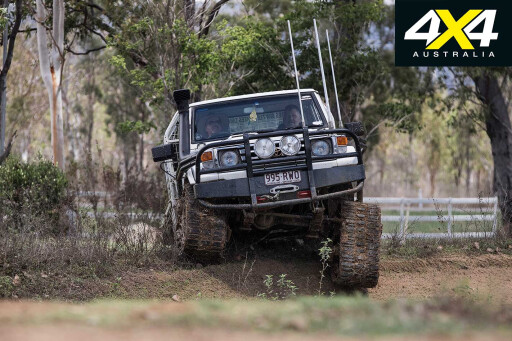 I smacked the right pedal as we dropped into a slushy creek bed and was rewarded with a spray of mud up the side. The truck just rumbled over the top of slush rather than sink into it, hurling a couple of very satisfying muddy rooster tails into the air behind me. Unsurprisingly, I was grinning like a fool by this stage.
I smacked the right pedal as we dropped into a slushy creek bed and was rewarded with a spray of mud up the side. The truck just rumbled over the top of slush rather than sink into it, hurling a couple of very satisfying muddy rooster tails into the air behind me. Unsurprisingly, I was grinning like a fool by this stage.
If the Cruiser was fitted with wheels it would’ve still made it through most of the places we took it, but it wouldn’t have done it as quickly or as easily. The only obstacles that posed any challenge to the Mattracks were large rocks, as the tracks tended to butt up against a boulder rather than roll over the top of it like an off-road tyre running low air pressures would.
 On my drive we clambered down soft, sandy creek beds and river tributaries, as well as wallowed in a bit of mud and, with the diff locks only needed on a couple of occasions, the Cruiser was effortless, with the units planting the truck solidly on the ground.
On my drive we clambered down soft, sandy creek beds and river tributaries, as well as wallowed in a bit of mud and, with the diff locks only needed on a couple of occasions, the Cruiser was effortless, with the units planting the truck solidly on the ground.
The CFA’s aforementioned Land Cruiser was tested for lateral stability in Victoria, where it reached a cross-slope angle of 50 degrees before threatening to tip. This was very apparent while clambering through the bush, as it remains stable and inspires confidence. They aren’t cheap, though. Depending on the US dollar exchange rate at the time, you’d be looking at about AU$55,000 to fit a set.
Installation
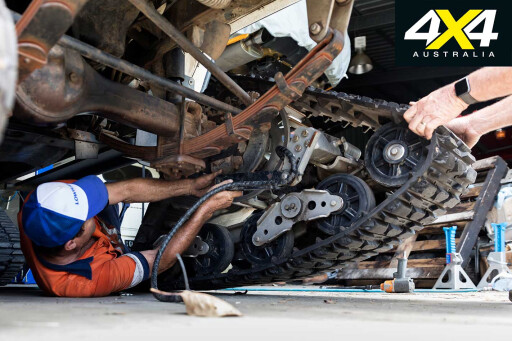 Mark Dooley, the owner and director of Fire Express Australia, demonstrated how to install the units, adding that a flexi head on the rattle gun is a big help when it comes to doing up the track nuts due to clearance issues. Installation isn’t too big of a job, but the track units are quite heavy – Dooley manoeuvres the units into place using a wheeled mechanic’s creeper.
Mark Dooley, the owner and director of Fire Express Australia, demonstrated how to install the units, adding that a flexi head on the rattle gun is a big help when it comes to doing up the track nuts due to clearance issues. Installation isn’t too big of a job, but the track units are quite heavy – Dooley manoeuvres the units into place using a wheeled mechanic’s creeper.
Rain, Hail or Snow It'll Go
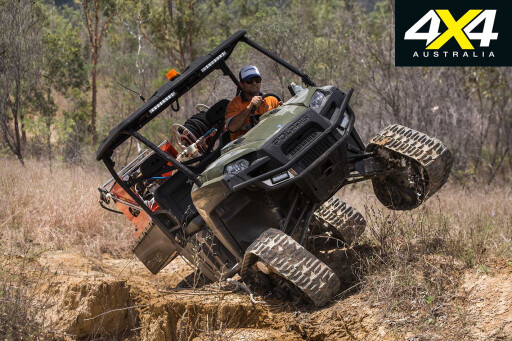 The tracks are most popular in snow applications – the Australian Antarctic Division uses them, as well as alpine fire and emergency services – but they’ve also found favour up in the tropics, where a couple of North Queensland stations use Mattracks-equipped Land Cruisers to get around during the wet season.
The tracks are most popular in snow applications – the Australian Antarctic Division uses them, as well as alpine fire and emergency services – but they’ve also found favour up in the tropics, where a couple of North Queensland stations use Mattracks-equipped Land Cruisers to get around during the wet season.

COMMENTS